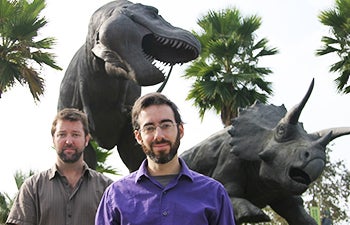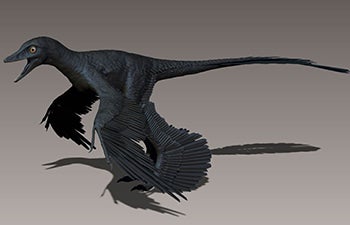Look! Up in the Sky!
The mystery of how dinosaurs first began to fly may have finally been cracked by a USC Dornsife-led team of scientists whose groundbreaking study has been honored by the Society of Vertebrate Paleontology (SVP).
The pioneering research by Justin T. Hall, Ph.D. student in integrated and evolutionary biology in USC Dornsife and Michael B. Habib, assistant professor in cellular and neural biology at the Keck School of Medicine of USC, solves the long-standing puzzle of how the crow-sized, four-winged dinosaur used its feathered hind legs to perform complex airborne maneuvers, allowing it to hunt prey or dodge obstacles some 130 million years ago.
Hall and Habib’s abstract was among ten selected by the SVP from 800 entries. The top 10 studies were presented to members and leading science media at the 72nd Annual Meeting of the Society of Vertebrate Paleontology held from October 17 to 20 in Raleigh, North Carolina.
Titled New Model for Hindwing Function in the Four-Winged Theropod Dinosaur Microraptor Gui, Hall and Habib’s research was conducted in collaboration with The Natural History Museum of Los Angeles County and David W.E. Hone of Queen Mary, University of London, United Kingdom.
“This study provides a plausible mechanism by which dinosaurs that otherwise have strongly Velociraptor-like bodies could take to the air and control themselves while in flight,” Hall said, referring to the genus of dinosaur most familiar to the public from its prominence in Jurassic Park. “Obviously crashing is bad for the long-term health of the animal, but until now we had little idea how the earliest flying dinosaurs avoided such catastrophes given their rather simple wing structure.”
Hall and Habib’s research overturns previous controversial theories on how the small, meat-eating dromaeosaurid dinosaur Microraptor gui deployed its wings — a hotly debated topic among paleontologists for nearly a decade.
When M. gui’s fossils were first discovered in north eastern China in 2003, scientists were excited by evidence that it not only had extensive lift-generating feathers on its arms, thus forming a set of wings, but that — unexpectedly for a vertebrate — it also possessed surprisingly long feathers on each leg, effectively forming a pair of “hind-wings.”
As dinosaurs are generally accepted by paleontologists to be the ancestors of modern birds, the discovery of Microraptor’s hind-wings sparked a debate about their importance in the evolution of birds from Velociraptor-like ancestors.
Until Hall and Habib’s study, the prevalent, albeit much-disputed, theory maintained that the small dinosaur glided between trees like a bi-plane. However, as critics pointed out, to do this the creature would have had to be a contortionist, possessing the ability to hold its hind legs out at a 90-degree angle to its body.
“The anatomical problem with the previous model is that essentially the animal was doing the splits and would have nearly had to dislocate its hips to get its legs into that position,” Hall said. “As anatomy instructors, Mike and I both knew it was physically impossible for the animal to have done that.

Justin T. Hall, Ph.D. student in integrated and evolutionary biology in USC Dornsife (left) and Michael B. Habib, assistant professor in cellular and neural biology at the Keck School of Medicine of USC, stand before statues of a Tyrannosaurus Rex and a Triceratops outside the Natural History Museum of Los Angeles County. Photo by Daniel Knapp.
“However, there wasn’t an alternative until we raised this new model which keeps the legs directly under the body in a way that is consistent with the posture we see in all known dinosaurs, in birds and also in the original specimen of this type of animal.”
Hall and Habib found additional reason to discount the original model when they studied whether it would improve M. gui’s performance in flight. “It turned out it made the animal worse both at flying and gliding than if it had used its front wings alone,” said Hall.
“Our model takes a common sense approach, that is very anatomically oriented and informed,” said Habib, who also teaches anatomy to USC Dornsife students.
“What is revolutionary is that we combined our knowledge of anatomy with an understanding of the aerodynamics of how animals actually fly,” Hall added.
Their research shows the forest dwelling M. gui would have been highly agile as it deployed its hind-wings to exercise deft control over tight turns used to dodge branches and other obstacles and hunt prey as it glided through prehistoric forests. Indeed, M. gui’s hind-wings improved its ability to “steer” to such an extent that it was able to turn twice as fast as a two-winged animal.
“For the first time, we appear to have a solid answer to the mystery of dinosaur hind-wings, as well as the function of the tail feather fan,” said Habib. “In the process, we have solved a major problem in the evolution of dinosaur flight —the problem of control.”
“Ever since the discovery of the first feathered dinosaur fossil in 1996, debate about the origins and mechanisms of powered avian flight has become increasingly contentious. In this new, elegant study combining analyses of aerodynamic capabilities and phylogenetic relationships, the inevitable conclusion is that dinosaurs were ‘experimenting’ with different body plans as they ‘learned’ to fly,” said Dr. Phillip Currie, SVP then-president and professor and Canada Research Chair in dinosaur paleobiology at the University of Alberta, Canada.
The implications of Hall and Habib’s research extend to the evolution of modern bird flight, including eagles. “People have been observing eagles sticking their legs straight out while making turns for thousands of years. We may have figured out some detail that they are using that helps them be more maneuverable,” Habib said.
The study will also allow scientists to generate predictions about the missing parts of an animal for which only partial fossil records exist. “For example, we only have fossil evidence of the wing and tail of another theropod dinosaur related to M. gui. Now we can generate predictions for what the front wing and tail of this animal probably looked like,” Habib said.
These predictions about the fossil record could also have interesting side implications for biological systems that are increasingly modeled for understanding engineered systems such as bio-inspired robotics.
Hall paid tribute to USC Dornsife’s strong focus on an interdisciplinary approach to research, which allowed him and other researchers to develop a close collaboration with The Natural History Museum of Los Angeles County. Hall’s co-advisers on the study were Jill McNitt-Grey, professor of biological sciences and biomedical engineering in USC Dornsife, and Luis Chiappe, curator and director of the Dinosaur Institute at the Natural History Museum, who was a co-author of the study.

Digital model of the crow-like four-winged dinosaur Microraptor gui showing its glossy black plumage. Model and photograph by David Krentz.
“We are excited to be at the forefront of this interdisciplinary approach by pushing the boundaries of what can be achieved in a close, working collaboration between a university and a museum,” Hall said. “It has enabled us to bring people together from different perspectives. Mike [Habib] and I come from the anatomical and mechanical viewpoints, while Luis [Chiappe] brings an expertise on fossil birds and how they relate to each other. We also had an opportunity to develop an international collaboration by working on some of the Chinese specimens.”
The SVP annual meeting was well attended by many of the most prestigious publications in the field including Science, New Scientist, The National Geographic, Scientific American and Science News. Several of these journals have already published articles on the subject, Hall said.
“I grew up a nerdy little kid who read the Scientific American, so that’s one that really hit home for me,” said Hall. “Our research has been fantastically well received. It’s wonderful as a scientist to get that sort of validation where the public and other scientists think what you are doing is interesting. This is so exciting and it’s such a huge opportunity for us.”
“Both Mike [Habib] and I really love teaching and having our research selected by the SVP as something they want to feature to the public as an example of why you should care about paleontology and ancient animals is a huge honor. It’s also a big responsibility, but most of all it’s a great opportunity for us to be ambassadors for science.”